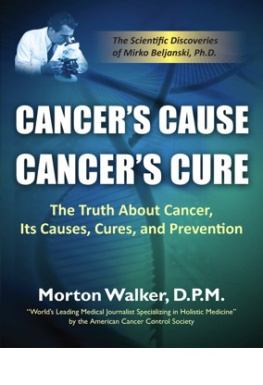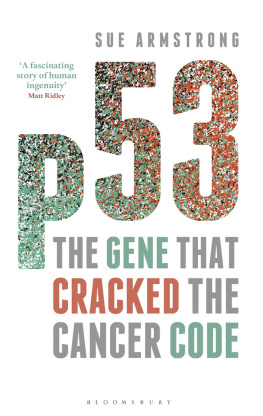The Science Masters Series
These books admirably achieve what the series sets out to do to explain exciting science clearly
Sunday Times
The whole series... manages to tell powerful stories very simply and very cheaply. What more could you want?
Science Now
The Science Masters series looks set to play a major role in the responsible popularisation of science
New Scientist
One Renegade Cell
This enthralling book explains exactly how our understanding of cancer has developed and just how tantalisingly close we seem to be getting to a cure
Scotsman
[It] should prove to be one of the most important popular science books of the year
Sunday Times
A riveting book... in gripping prose and ripe metaphor, Weinberg tells the story of the hunt for the enemy hidden within the genetic programme of cancerous cells... He predicts in One Renegade Cell [that] scientists will soon know all there is to know about this mysterious executive deep in the cells nucleus. And then, at last, a cure for cancer?
New Scientist
ONE RENEGADE CELL
The Quest for the Origins of Cancer

ROBERT WEINBERG

CONTENTS


The work of many colleagues, too numerous to mention, has provided me with the insights that made the writing of this book possible. William Frucht, Senior Editor of Perseus Books, helped me convert my original text into one far more readable. I am very grateful to him.

Cancer wreaks havoc in almost every part of the human body. Tumors strike the brain and the gut, muscles and bones. Some grow slowly; others are more aggressive and expand quickly. Their presence in human tissues signals chaos and a breakdown of normal function. Cancer brings unwelcome change to a biological machine that is perfect, marvelously beautiful, and complex beyond measure. Wherever tumors appear, they take on the appearance of alien life forms, invaders that enter the body through stealth and begin their programs of destruction from within. But appearances deceive: The truth is much more subtle and endlessly interesting.
Tumors are not foreign invaders. They arise from the same material used by the body to construct its own tissues. Tumors use the same components human cells to form the jumbled masses that disrupt biological order and function and, if left unchecked, to bring the whole complex, life-sustaining edifice that is the human body crashing down.
How are human tissues put together from single cells? The description above might suggest the involvement of master builders who oversee crews of workers, directing them in the detailed construction of normal and malignant tissues. In reality, there are no overseers forcing throngs of cells to line up and assemble themselves into normal or cancerous tissues. Architectural complexity in living tissue comes from the bricks themselves, the individual cells. Control is exercised from the bottom up.
Normal and malignant cells know how to build. Each carries its own agenda that tells it when it should grow and divide and how it should aggregate with other cells to create organs and tissues. Our bodies are nothing more than highly complex societies of rather autonomous cells, each retaining many of the attributes of a fully independent organism.
Right there, we confront great beauty and profound danger. The beauty lies in the coordinated behavior of so many cells to create the single, highly functional cooperative that is the human body. The danger lies in the absence of a single overseeing master builder, which seems to put the whole enterprise at great risk. Granting autonomy to trillions of worker cells invites chaos. When, as usually happens, these cells are well behaved and public-spirited, extraordinarily complex order ensues. But on occasion, a cell may choose to go its own way and invent its own novel version of a tissue or organ. It is then that we see the much-feared chaos that we call cancer.
Most human tumors comprise a billion or more cells before we become aware of them. The cells within a tumor differ from their normal counterparts in many respects, exhibiting distinctive shapes, growth properties, and metabolism. The sudden appearance of such a horde of cells would seem to reflect some recent mass conversion, in which millions of normal cells enlisted overnight in the ranks of a tumor mass.
Once again, appearances deceive. The creation of a tumor is an extraordinarily slow process, often extending over decades. The cells forming a tumor are all lineal descendants of a single progenitor, a distant ancestor that lived many years before the tumor mass became apparent. This founder, this renegade cell, decided to go off on its own, to begin its own growth program within one of the bodys tissues. Thereafter, its proliferation was controlled by its own internal agenda rather than the needs of the community of cells around it.
So there were no millions of recruits, only a single one that spawned a vast horde of like-minded descendants. The billions of cells in a tumor are cast in the image of their renegade ancestor. They have no interest in the well-being of the tissue and organism around them. Like the founder cell, they have only one program in mind: more growth, more replicas of themselves, unlimited expansion.
The chaos they create makes it clear how very dangerous it is to entrust each cell in the human body with its own measure of independence. Still, that is how we are put together, and how all complex, many-celled organisms have been designed for the past 600 million years. Learning this, we realize that the chaos of cancer is not a modern affliction but a risk run by all multicellular organisms, from ancient to modern. Indeed, given the trillions of cells in the human body, is it not a wonder that cancer does not erupt often during our long lives?
THE INTERNAL BLUEPRINT
To understand how a tumor grows, we need to understand the cells that form it. What caused that single founding cell to run amok? More generally, how does any cell, normal or malignant, know when to grow? Do cells have their own minds? And if not, what complex decision-making apparatus inside the living human cell determines its growth, quiescence, or death?
Our focus in this book is on the internal program carried by each normal human cell that tells it how and when to grow and associate with other cells to create the highly functional communities that are human tissues. The programs carried by various cells represent complex biological scripts, blueprints for their behavior. As we shall see, it is this internal program that is altered when cancer begins. Only after we understand this program in its normal and damaged forms can we understand the engine that drives the cancer cell.
There are several hundred types of cells in the human body. These various cell types aggregate to form distinct tissues and organs. Knowing this variability of individual cells, we might imagine the existence of a correspondingly large number of distinct scripts, each carried by a different cell type, each dictating a distinct agenda of growth and tissue-forming abilities. Here our intuition leads us astray. In truth, the cells in different parts of our body in the brain, muscles, liver, and kidneys as different as they appear, are really very much alike and, unexpectedly, all carry the same blueprint.
Next page












